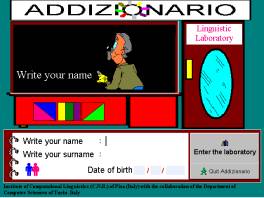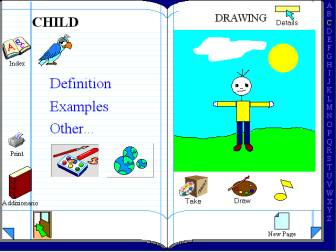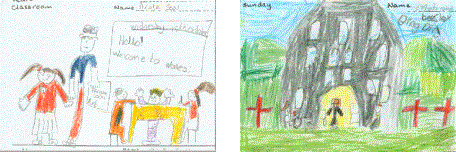|
|
|
Consciousness, Literature and the Arts
Volume 4 Number 1, April 2003
_______________________________________________________________
a
proposal
By
L.Cignoni,
L.Godding, G.Salvoni, G.Turrini
This
paper presents a proposal, addressed to primary school children between 8 and 11
years of age, for exploitation of the multilingual version of the software
Addizionario. The phases of the methodology are described in which the children
from different countries, after working with Addizionario, produce material to
be exchanged and used by their peers for mutual culture and language learning. An
experiment carried out within
the framework of the Socrates-Comenius project in Italian and Welsh schools is
described, with the presentation of the data collected in Italian and Welsh
schools.
The
proposed methodology could also be used in schools for the integration of
immigrant children and for the preservation and valorisation of minority
languages.
Keywords
Multimedia
software, primary school teaching/learning, peer teaching/learning, foreign
languages, culture preservation
Addizionario[1]
is a multimedia tool addressed to primary school children, initially designed to
study the Italian language in an easy and amusing manner.
The original idea lying behind this software was the awareness that it is
possible to increase the interest and enthusiasm of children towards language if
they are motivated and directly involved in activities carried out in
collaboration with teachers and classmates. Addizionario suggests a new approach
to language learning which envisages direct
involvement of the child in the gradual construction of his competence.
The
software is composed of two correlated multimedia modules:
a)
a Dictionary for children, written and illustrated by the children
themselves, whose name Addizionario
has been extended to include the whole system;
b)
an Activity Book in which children can work and reflect on language.
The
Dictionary contains the definitions, examples, drawings and free associations
that 400 children of primary schools from various regions of Italy produced for
around 1,000 words, among the most frequently used by young pupils.
The
Activity Book, the creative module of Addizionario, makes it possible to perform
a wide variety of activities on language, including the construction of one’s
personal dictionary. For every word introduced in the dictionary, the child is
free to perform the number of tasks he wishes, either textual or non-textual,
which appear in the menu.
The
textual activities include the production of definitions, examples, free
associations, idiomatic expressions, synonyms and antonyms if they exist, as
well as verbs and adjectives which can be associated with the word in question.
The writing of invented stories and personal experiences is another important
task which can help the child become actively involved in the work.

Entering
Addizionario
The
non-textual activities consist in handling the multimedia aspects of the system.
The children can produce their own drawings, record sounds, or can use the
material already available in the archives of the system. With particular regard
to the drawings, it is possible for the children to use the material which has
been produced on paper previously and then transferred into the Activity Book by
means of a scanner. If the child wishes to create drawings on the computer
directly, or prefers to personalize those taken from the archives, simple tools
such as pencils, an eraser, paint, scissors, etc. can be employed. On the
drawing the child can construct in a simple and easy manner “hot areas”
highlighting different parts or details of the image and these details can also
be added to the Activity Book as new words.

The
Activity Book
From
the early phase of implementation of Addizionario, we were convinced that the
material collected would shed light on the emotional world of the children,
their personal experiences and everyday lives, revealing their inner feelings,
sentiments of love, fear and hope, and supplying us with precious and genuine
material. The various tasks were typical classroom activities, but the material
produced by the children opened a window into the social and cultural reality
and physical ambience in which they were immersed. Therefore, the study of the
data produced during experimentation in numerous schools both in Italy and
abroad encouraged us to formulate the proposal, described in detail in section
4.
 Availability
of a multilingual (English, French, German, Italian, Spanish) version of the
system described above, and the possibility of personalizing the software with
respect to the language of interaction, offer new perspectives of application of
the tool both in Italy and abroad.
Availability
of a multilingual (English, French, German, Italian, Spanish) version of the
system described above, and the possibility of personalizing the software with
respect to the language of interaction, offer new perspectives of application of
the tool both in Italy and abroad.
2.
Proposal
The
increased awareness, underlined by numerous documents issued by the European
Community, of the necessity for pupils to know two or more languages to
facilitate communication between the people of different countries, has become a
crucial issue.
A
growing number of multimedia tools and methods recently issued on the market
seem to be very promising for the learning of a language in a more rapid and
efficient, less difficult manner. However, the users soon realize that they are
not always adaptable to their requirements: they supply the structures of a
language, but not together with the information necessary to introduce the
learner into the physical, social and cultural world in which the language in
question is developed.
Taking
these needs into account, and considering the possibilities offered by
Addizionario, we suggest use of the tool for language learning, based on mutual
teaching and on the exchange of knowledge and cultural data between children of
the same age (8-11 years), belonging to different linguistic communities.
With
this aim, Addizionario can be used in Italy and in other countries of the
European community, where the pupils of the schools are more and more involved
in projects of partnership and collaboration with their peers.
The
didactic procedure we propose consists in the five following phases:
a)
a set of words the teachers have previously agreed upon, chosen among the
most common and closest to the world of the children, are submitted in parellel
in their native language to the classes of two or more partner schools
participating in the project;
b)
each group of children work on their native language using Addizionario
in an intercultural perspective. The awareness that the material they are
producing will be useful to their peers of another country and the willingness
to speak about themselves and about their everyday lives act as strong
motivating factors. With the aid of the teacher who covers an important
and crucial role in conducting the activities, they prepare didactic
units, performing all the activities envisaged by the Activity Book: the words
chosen will be supplied with pronunciation, definitions, examples, associations,
sounds, drawings, etc.;
c)
the children exchange and analyze the material specifically prepared for
them by their peers;
d)
they learn and memorise new words and grammar structures using them in
different contexts. Addizionario makes it possible for the children to practise
the four basic skills (reading, writing, listening, speaking). While achieving
the first notions of another language, they are helped to look at things from
different points of view, in order
to understand better the emotions, habits, physical and social environment of
their partners;
e)
in the final phase, the children compare the data of their peers from the
other country with their own. The exchange of information and experiences with
these pupils allows them to discover similarities and differences, both
linguistic and cultural between the two countries, and to understand that ideas
and concepts generally taken for granted are determined by one’s cultural
background. They are encouraged to learn about how other children live, but at
the same time they are made to reflect about themselves, about their history and
national identity.

Welsh
children’s drawings for classroom and Sunday
3.
Italian-Welsh collaboration
The
first experimentation of the procedure described above is currently underway and
involves a number of Italian and Welsh schools. Contacts with Wales were started
in 1996 within the framework of a Comenius project in which this part of Great
Britain was partner of the primary school of Capannori (Lucca, central Italy)
which at that time was working with the first prototype of Addizionario. Lesley
Godding, at that time headteacher of the Glynhafod Junior School, Cwmaman,
Aberdare, Rhondda-Cynon-Taff, Wales, expressed a strong interest in the tool,
and suggested to use it for a joint-project
between the two countries.
Work
with Addizionario was conducted first on paper and then on computer using a
rather faulty and hasty English
version of the system. At present, with the availability of the multilingual
version, experimentation can be carried out with full satisfaction and without
major problems.
What
follows are some of the data - produced by the children of the two countries -
which at a first glance seem to be of some interest. While the Italian data come
from schools of different types and from various regions of Italy and reflect a
more heterogeneous background, the British data all come from a rather depressed
area of Wales, badly hit by the rapid decline of the coal industry.
From
even a small sample of material, it is possible to receive
information as to how the children of the two countries spend their
Sundays, what type of food they eat, their relationship with parents and
relatives, their favourite games, surrounding environment and traditions.
Particularly
interesting were the definitions that reflect the children’s personal,
concrete experiences, associated feelings and impressions. When speaking about
themselves, the children also provide information about their daily experiences
and cultural aspects of their everyday lives.
3.1.
Production
Sunday
for Welsh children is usually a day of
rest, when you eat a cooked dinner, which is a
meal that has meat in it. Parents
don’t generally work on that day and often go shopping with their
children, and this is made possible by the fact that most stores in Wales are
open on Sundays, unlike Italy where they often have a Sunday opening once a
month.
An
Italian boy visits new places with his
parents every Sunday, while another one goes to
buy cakes at the confectioner’s, a typical Italian habit. Strong affection
is shown for parents and relatives alike. For an Italian child, mother is the person
who prepares cakes and bottle-fed him
when he was a baby, while daddy is
the person who brings presents. Grandmother, which the Welsh children call granny
or nan, is a person they visit on Sundays or where they go to
sleep for the night.
A
classroom for Italian children is a place
where they get together and study in a pleasant manner and
without interruption, while for a Welsh boy it is a place where
they work all day and which has six
tables and six groups in it. For the Welsh children, a computer is used to
write out a story, or letters, or do your homework, while for the Italian
children it is an intelligent machine,
a type of television
with which one can write, play, draw and work, and which is very
fussy.
The
word child was defined by an Italian
pupil as a very young person destined to
become old if he doesn't meet any
obstacles in the meantime and represented with a blue ribbon hanging on a door. In Italy, when a new baby is born, it
is the custom to place a blue ribbon ‑ in the case of a boy, a pink ribbon
‑ in the case of a girl, on the door of the house.
For
a Welsh pupil, a
boy has short hair and wears one earring in his left ear,
and this description is also reflected in the drawings the children have made.
From
a comparison of the material produced by the children of both countries for the
word carnival, it emerges that the
celebration, metaphorically described as an
outside circus, or a moving
entertainment, is different in the two countries. In Italy it is celebrated
in February - and the children emphasize on dressing up in fancy clothes and
throwing streamers at one another, - while in Wales it is celebrated in August,
when many people are on holiday and the weather is more reliable.
The
impression we receive is that despite the weather conditions which in Britain
are far worse than in other more southern European countries, outdoor activities
with games such as the bean-bag or the wheelbarrow race are a lot more frequent
and intense, while football is definitely the favourite sport for Italian boys.
The
children of both countries explain that a forest has a
lot of trees of different types, plants and shrubs, with animals like
squirrels and owls for the Welsh, while some of the Italian children also
associate a forest to the idea of a dangerous, dark, bewitched and fearful
place, with wolves.
Italian
families commonly use the aeroplane for business, while for Welsh children this
means of transport (a big giant bird, an airy
piece of machinery that flies) is essentially associated with holiday-making
to Spain or to Greece.
Finally,
the drawings of the Welsh are generally less colourful and elaborate than those
produced by the Italian children who are innately more extrovert, but in both
cases they always reflect the everyday life and social experiences of the
children. For example for the word church,
one of the drawings represents the congregation immediately before or after the
service, with a handicapped person on a wheel-chair. The buildings represented
by the Welsh children are those typical of British architecture, in Gothic style
and with mosaic windows. The tombs are located in the churchyards, a feature
that is not present in Italy where the graves are generally found only in the
cemeteries.
We
have presented a proposal for the exploitation of Addizionario as a
teaching/learning language tool. The same methodology can also be used to
preserve and valorize the minority languages, as well as to promote and foster
initiatives for welcoming and protecting the language and culture of origin of
immigrant pupils. The levels of use of Addizionario are not predefined, and
therefore it can be appropriately exploited by pupils of various ages and
abilities, adapting to their different needs. The Italian students can be
involved in processes of reciprocal enrichment, where the presence of
non-Italian cultures is a resource and not a problem. Linguistic and cultural
differences should in fact be considered as positive values, laying foundations
for mutual respect, cultural exchange and tolerance.
The software can be also useful to the teachers working with textbooks
which do not always take into account non-Western and non-Christian cultures.
Alvarez
Lopez C., 1998, Le parole-chiave di un’esperienza spagnola, in A.A.V.V., “Si può
fare”, Atti del Convegno internazionale, Lucca.
Bruner
J., 1996, The Culture of education,
Harward University Press.
Cangià
C., L’altra glottodidattica, Giunti,
Prato.
Cignoni
L., Lanzetta E., Pecchia L., Turrini G., 1996, Children’s
Aid to a children’s Dictionary, in M. Gellerstam, J. Järborg, S.-G.
Malmgren, K. Norén, L. Rogström, C. Röjder Papmehl (eds.), Proceedings of
the Seventh EURALEX International Congress on Lexicography, Göteborg
University, Sweden, 659-666.
Ciliberti
A., 1994, Manuale di glottodidattica,
La Nuova Italia, Firenze.
Commissione Europea - DGXXII
“Istruzione, Formazione, Gioventù”, SOCRATES: Linee
guida per i candidati.
Cresson E., 1995, Insegnare
ad apprendere. Verso
la società conoscitiva,
Commission Européenne, 1995, Einsegner et
apprendre vers la socièté cognitive. Livre blanc, Office des pubblications
officielles des Communeautées européennes, Luxemburg.
Godding L., 1998, L’istruzione
elementare in Inghilterra e Galles, in A.A.V.V., “Si può fare”, Atti
del Convegno internazionale, Lucca.
O’Shea T., Self J., 1983, Learning and teaching with computers, The Harvester Press.
Prat Zagrebelsky A.T., 1998, Lessico
e apprendimento linguistico, nuove tendenze della ricerca e pratiche didattiche,
La Nuova Italia.
Susi F., 1999, Come
si è ristretto il mondo - L’educazione interculturale in Italia e in Europa:
teorie, esperienze e strumenti, Armando, Roma.
Talamo A., 1998, Apprendere
con le nuove tecnologie, La Nuova Italia, Firenze.
Turrini
G., Cignoni L., Paccosi A., 2001, Addizionario: a Pupil's Innovative Tool for
Language Learning. An International Peer-Reviewed On-Line Journal “Educational
Technology and Society”, Vol. 4, Issue 2, URL http://ifets.ieee.org/periodical/vol_2_2001/turrini.pdf.
[1]
The
software was implemented
at the Institute of Computational Linguistics (ILC) in Pisa, in
collaboration with the Department of Computer Sciences of Turin University,
and patented by the Italian National Research Council (CNR) of Italy.